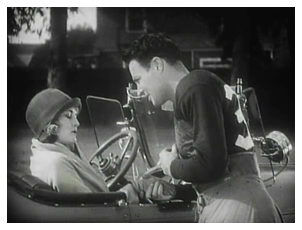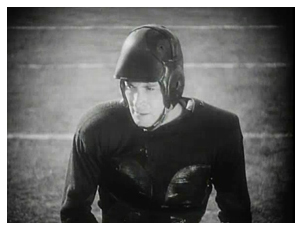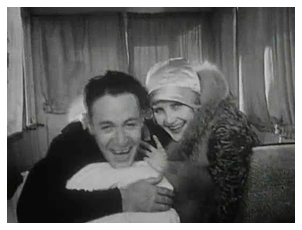

Directed by Edward H. Griffith
Produced by DeMille Pictures Corporation
Premiered May 14, 1928
Cast: Rod La Rocque (Jaime Alvarado Montez), Jeanette Loff (Helen
Bradbury), Hugh Allan (Jack, Helen's brother), Joseph Cawthorn
(Professor George Bradbury), Tom Kennedy (the detective), Jerry
Mandy (Jaime's Valet)
Thanks to the New Zealand Film Archive and National Film Preservation Foundation (NFPF), several American films that were previously considered lost are now available for viewing online at the NFPF's website (http://www.filmpreservation.org/preserved-films/lost-and-found-new-zealand).
Silent films fans most likely have a copy of the "Lost
and Found: American Treasures from the New Zealand Film Archive"
DVD release from 2013 that offered several of the films that were
found in the New Zealand Film Archive and repatriated to the U.S.
The link above provides seven features and a variety of shorts
free to view online, including the feature being reviewed here,
"Hold 'Em Yale" (1928) with Rod La Rocque. The other
features include:
"Defying Destiny" (1923) with Monte Blue and Irene Rich
"The Hidden Way" (1926) with Mary Carr, Gloria Grey,
Tom Santschi, Arthur Rankin, and Ned Sparks in an early role
"Maytime" (1923) with Harrison Ford and Clara Bow (only
4 reels of 7 survive)
"Midnight Madness" (1928) with Jacqueline Logan and
Clive Brook
"Reckless Youth" (1922) with Elaine Hammerstein (first
reel is missing)
"Unseen Forces" (1920) with Sylvia Breamer and Conrad
Nagel
Depending on your tastes, "Hold 'Em Yale" may not be the best feature in this lot. However, in spite of some negative contemporary reviews (albeit some praised the film, as well), it has a lot to offer.
Here's what it's about: Rod La Rocque is Jaime Montez from Argentina. Jeannette Loff, as Helen, and her dad encounter Jaime while they are in Argentina but mistake him for a bandit. Jaime immediately falls in love - and although he had previously planned to refuse an opportunity to go to Yale, he changes his mind quickly when he learns that Helen lives in New Haven, and her father is a professor at Yale. Once there, though, he is told that he must do something "big" at Yale if he is to win a girl like Helen. He is given the opportunity to win the heavyweight boxing title for Yale against Harvard's champ, but, after knocking his opponent down, he foolishly turns to Helen in the seats to gloat over his supposed victory. His opponent recovers and surprises Jaime with a knockout. Ridiculed by his Freshman Class, he considers returning home, but Helen's father convinces him to try out for the football team. Over the summer, Jaime trains relentlessly at his home in Argentina and returns to become a star on the football field. However, the night before the big game with Princeton, he is injured in an auto accident trying to save Helen's brother from a impulsive, drunken marriage. Nevertheless, Jaime escapes from the hospital to arrive at the last minute and win the game. Oh, by the way, throughout the story he is hampered in everything he does as he is chased continuously by a dumb detective (Tom Kennedy) who is convinced Jaime is wanted for something!
Nope, nothing original there, but it's a fun romp that doesn't pretend to be more than it is. Rod La Rocque was capable of doing comedy, but it was a style all his own - not in the realm of slapstick, but a stylish persona that wasn't afraid to appear foolish at times.
A technique that always boosts a narrative -- if it's done
well -- is to have a side story that runs throughout the film
but alongside the main story. Basically, we have a film about
a  young
man in love trying to make it at Yale and win the girl. But, probably
the best part of "Hold 'Em Yale" is the dumb detective's
pursuit of Jaime. What makes it all the more enjoyable is it's
always a surprise, because we never know when the detective is
going to appear and what Jaime will have to do to escape him.
young
man in love trying to make it at Yale and win the girl. But, probably
the best part of "Hold 'Em Yale" is the dumb detective's
pursuit of Jaime. What makes it all the more enjoyable is it's
always a surprise, because we never know when the detective is
going to appear and what Jaime will have to do to escape him.
So why is the detective chasing Jaime? Upon his arrival at the train station, three upperclassmen decide to pull a prank on this new freshman. Jaime is told he must ride the freshman bus to the campus, so the three upperclassmen direct him to a patrol wagon that is sitting there with its doors open waiting for a prisoner. When Jaime emerges from the wagon at the police station, he tells the detective there is a mistake. The detective responds, "Lissen, Handsome. A guy like me never makes no mistakes." At that moment, Jaime sees Helen down the street about to drive off and runs to jump on her moving car. The detective sees this as an attempt to escape, and the pursuit throughout the movie is on!
Since we've quoted one of the intertitles above, let's be sure and note that the intertitles, attributed to John Krafft, are well-written and witty - especially Tom Kennedy's hilarious determination that Jaime is wanted for something. For example, in one instance, when Jaime escaped him, he said, "He's the spittin' image of a guy what's wanted in Seattle." The next time it's, "Sump'n tells me he's the guy what's wanted in Memphis." When he sees Jaime's picture in the paper, he says, "I'm gonna get that guy! He's the egg what socked me on the jaw from St. Looey." And the detective's bungling of not only his efforts to capture Jaime but his sentences is portrayed in intertitles like, "Where's that dark crook with a tall mustache?" or "Ain't you the guy what hit me with a black mustache?" Or the inane, "Now lissen, lady -- how long have you known this crook? Answer Yes or No." And there are other clever ones such as one double entendre with Helen introducing Jaime by saying, "Father, this is the bandit who kissed me - in the Argentine."
At least one review referenced the "profound slapstick" (1) in the film, and the description on the NFPF site mentions "slaptsick," but this could be misleading depending on your definition. Yes, there is a bit of physical humor, but anyone who hasn't seen the film should not have visions of a Keystone comedy. Maybe the reviewer was referencing a scene where Jaime poses as a moving man with a big chaise lounge over his back to get out of Helen's house without being recognized by the detective. The detective offers to take it from him, which Jaime does without showing his face. Once the detective has the piece of furniture on his back, Jaime pushes him down with his foot and runs out the door. Tom Kennedy riding a bicycle through town as he's chasing Jaime and running into the traffic cop certainly smacks of some of the old-time slapstick, but the viewer should know that "Hold 'Em Yale" leans more toward situational humor with minimal laughs dependent on the physical stuff.
We've admitted that there's really nothing about the film
that is original, yet La Rocque and company elicit a number of
smiles and laughs with their protrayals of these routines and
situations. For example, Jaime is hiding in a high-back chair,
Helen standing at the back of the chair between him and the bungling
detective. With her arm back behind her, he reaches inside her
arm to place a note in front of her face that says, "I love
you" while the detective is looking the other way. However,
he turns before Jaime can remove his arm, so it's the old gag
of the person behind acting as if their arm is actually the arm
of the person in front - got it?? Anyway, between La Rocque's
effeminent hand motions, Loff's excellent reactions to his playfulness,
and Tom Kennedy's quizzical studying of the situation, it works
 hilariously
well. He also gets a pretty good guffaw from us when Loff puts
the note down the front of her dress with her free arm and La
Rocque reaches in to get it with his arm, and, of course, it then
appears if she is slapping her own hand!!
hilariously
well. He also gets a pretty good guffaw from us when Loff puts
the note down the front of her dress with her free arm and La
Rocque reaches in to get it with his arm, and, of course, it then
appears if she is slapping her own hand!!
The last minutes of the film are, indeed, exciting, as well. Jaime is was out the night before the big game - which he shouldn't have been - players are in bed by 8 p.m. on these nights. He is involved in a car accident and is in the hospital the next day with a pretty serious shoulder injury that's causing him quite a bit of pain. To add to his problems, the detective is guarding his door so he can't get away, and the big game has started.
Of course, he does make it to the game and saves the day. The ending is not only exciting for a pretty good game sequence (with shots from a real contest at the Yale Bowl), the detective is on his trail, Helen won't speak to him because she thinks he was out with another girl the night before, and he's having difficulty playing due to the injured shoulder. All added together, this makes for a pretty good climax!
The main criticism that seemed to come from reviewers was that they were tired of the college theme - all with the hero winning the big game in the final seconds. This deluge of college films apparently took off after the success of Harold Lloyd's "The Freshman" three years earlier. However, the story on which this is based is a 1906 stage play entitled "At Yale" by Pulitzer Prize-winning playwright Owen Davis - so the story actually does predate Lloyd's film. Nevertheless, one can understand how the timing opened "Hold 'Em Yale" up for these criticisms.
By the way, in the following reviews, note that the film is sometimes referred to as "At Yale" rather than "Hold 'Em Yale." The reviews from May or June all use "Hold 'Em Yale" as the title. Late July and August reviews call it "At Yale." It is unknown why there was a change in the film's title.
Variety gave one of the harshest reviews. "If it weren't for Tom Kennedy, playing a comedy detective, 'At Yale' would have nothing to recommend it. . . Kennedy is excellent," adding, "For the serious minded on campus and football technique, the omissions and commissions here are so glaring as to make the picture ridiculous." (2)
 The New
York Times called it "amusing," but that was about
all the praise the reviewer could muster. "A careful analysis
would bring tears of pain to graduate eyes, of course, but Mr.
Edward H. Griffith, who directed the picture, apparently has had
experience enough to know that it is wise to go easy on collegiate
activities. Thus, the greater part of the play might have happened
about anywhere and, consequently, through some good titles and
profound slapstick - 'At Yale' has it moments. As they would say
in New Haven, the picture as a whole rates about a 65. The passing
mark is 60."(3)
The New
York Times called it "amusing," but that was about
all the praise the reviewer could muster. "A careful analysis
would bring tears of pain to graduate eyes, of course, but Mr.
Edward H. Griffith, who directed the picture, apparently has had
experience enough to know that it is wise to go easy on collegiate
activities. Thus, the greater part of the play might have happened
about anywhere and, consequently, through some good titles and
profound slapstick - 'At Yale' has it moments. As they would say
in New Haven, the picture as a whole rates about a 65. The passing
mark is 60."(3)
Harrison's Reports simply said, "Not much to it!" (4)
But then there were those who liked the film. The Motion Picture Magazine reviewer said, "Director E.H. Griffith breathed life into a stereotyped movie yarn from the pen of Owen Davis. And in doing so has made a farce so good that one easily forgives the triteness of the tale." (5)
We agree with Photoplay's assessment. "What's the use of being critical when you've had your money's worth of honest fun out of a picture?" (6)
In our opinion, it is the cast that puts this one over. La Rocque is very good and is always a likeable character in his films. Thankfully, we have several of his silents available for viewing. The quality, admittedly, is mixed, but most are well above the average programmer of the time. La Rocque made it successfully into the sound era in supporting roles (he also was the star of a series of "Shadow" pictures) ending his career with the wonderful "Meet John Doe" in 1941. His life is one of those happy endings with a life-long marriage to Vilma Banky that lasted from 1927 until his death in 1969.
Loff is a welcome addition - pretty, appropriately animated and charming in her part. "Hold 'Em Yale" was only her fourth feature. She did continue in films through 1934 and, with a background in theatre, offered a very pleasant singing voice in her sound films. (Check out YouTube for several videos of her songs.) Unfortunately, she passed away young, at 35 years of age in 1942 from ammonia poisoning.
Regarding the acting honors in "Hold 'Em Yale," we do have to agree with the reviewers, though. Tom Kennedy easily garners the highest praise as he lifts the film's enjoyment quotient significantly. Jaime's monkey goes to college with him, too, a small, cute and mischievous primate who adds to the hilarity. We don't see any mentions of Jerry Mandy who plays Jaime's Argentine valet - a very well-played, kookie character, that, although minor, adds delightfully to the humor.
"Hold 'Em Yale" is one of a number of films produced by DeMille Pictures Corporation, an ill-fated venture into the production arena by DeMille that lasted from 1925-1928. Unfortunately, most of the DeMille Pictures output failed to recoup their costs. However, we're not surprised that"Hold 'Em Yale" was one that showed a profit with a production cost of $240,455 and box office receipts of $299,485. (7)
Check out "Hold 'Em Yale" online. It's good quality, but, unfortunately, does not have a music track. Hopefully, we'll see a "Lost and Found: American Treasures from the New Zealand Film Archive Volume 2" DVD release that will include several of these wonderful films.
References
1. "At Yale" review. New York Times. July 30,
1928.
2. "At Yale" review. Variety. August 1, 1928.
3. New York Times.
4. "Hold 'Em Yale" review. Harrison's Reports.
May 19, 1928.
5. "Hold 'Em Yale" review. Motion Picture Magazine.
June 1928.
6. "Hold 'Em Yale" review. Photoplay Magazine.
May 1928.
7. Birchard, Robert. Cecil B. DeMille's Hollywood. The
University Press of Kentucky. 2004.
Copyright 2015 by Tim Lussier. All rights reserved